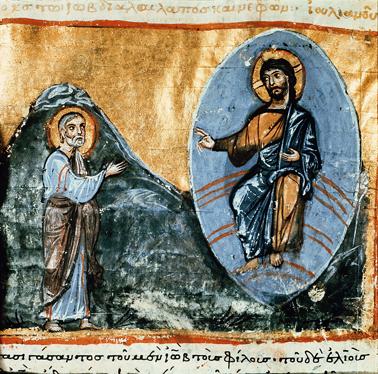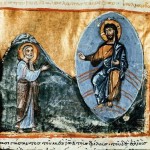
Job 1:1, 2:1-10 or Genesis 2:18-24
What It’s About: This is a really strange juxtaposition of texts. The Job text is the setup for the book of Job; it’s the kernel of dramatic irony that centers the whole book, in which God and the Satan (more on him in a moment) strike a deal concerning the life of Job. The Genesis text is that section of the book where God is creating things in the more material kind of way (as distinct from the speech-act creation in Genesis 1). The common thread to both texts is that they both mention women. Job’s wife, in verse 9, advises him to “curse God and die,” and in the Genesis passage God creates woman out of man. But this commonality is forced, I think, and the two passages really go in very different directions, with different implications for the tone and tenor of your day.
What It’s Really About: The Job text is really about a cosmology that no one accepts anymore. Here, Satan isn’t the embodiment and personification of evil, as he comes to be later on, but he is instead a functionary in God’s heavenly court. His name, ha-Satan in Hebrew, means something like “the adversary” or “the accuser.” Scholars often refer to his role as something like a prosecuting attorney, bringing cases of human sin before God for judgement. God and Satan are on the same team here–which is the part that no one much accepts anymore. They team up to conspire against Job, and really, knowing what’s about to transpire, Job’s wife’s advice doesn’t seem all bad. This is a cosmology that understands that the moral scales are hopelessly weighted against human beings, and we know (but Job does not) that his goodness or badness has little impact on the suffering he is undergoing.
The Genesis text is from the second of Genesis’ two creation stories. In the first one, God is ethereal, vocal, and somewhat detached. But in this one, God is hands-on, and very tactile. Just think about how this story goes: Adam is lonely. So God sets out to fix that. And so God makes…a koala bear. Nope, that doesn’t do it. Adam is still lonely. So God makes a centipede. Nope, that’s not right either. An otter. Nope. A falcon. Nope. On and on, God creates things that God hopes will provide companionship to the man, and in so doing God creates the millions of species of animals that populate our world. In this view of creation, every living thing on earth is God’s mistake, in a sense. Each living creature is an example of God not understanding quite what Adam needs. Only at the end, after much trial and error, did God create the woman, who at last satisfied the man. This is starkly different from the God of Genesis 1, in that it presents a God who doesn’t know where things are going until they arrive. And it’s a different view of creation too–creation, in this view, is much less intentional and much more of a happy accident.
What It’s Not About: It’s not about Satan as ontological evil. Satan didn’t really fill that role until near the New Testament period. It might be a natural by-product of monotheism to need a counterbalance. Think about it: in polytheism, you can easily explain away evil and suffering as the work of some other god–one that you haven’t appeased. But in monotheism, the buck always stops with the deity. I wonder if Satan developed from one of God’s lieutenants into a kind of slightly-less-powerful counter-God in order to explain away evil and suffering, and not have it come from God?
Maybe You Should Think About: Both of these stories are powerful and rich. On World Communion Sunday, there may be potent ways to leverage them to inform the work the congregation does at the table. What does the cosmology of Job tell us about human being? What does the creation of Genesis 2 tell us about our world. World Communion Sunday is part of the ecumenical effort, and ecumenism comes from the Greek for “the whole world.” Where does that vision of a unified world Christianity intersect with these two visions of the world?
What It’s About: This is about prophets, angels, children, and a Son. It’s a strange argument, but it’s one that builds on history as a way of explaining who Jesus is and how Jesus figures into God’s ongoing work. It contains some statements (hello, verse 9) that would be suspect in light of later theology and Christology, but really this is just a document trying to tell the story of Jesus. Many scholars think Hebrews was a sermon, given possibly in Rome, and possibly to people who would have understood a lot of Israel’s history (so, not recent gentile converts). You can see that at work here, as the speaker/author is using categories from Hebrew scripture (probably mediated through the Septuagint) to describe who Jesus is. You see Paul doing the same thing in his letters: grasping for metaphors and comparisons to explain a phenomenon that was really unexplainable.
What It’s Really About: The effect of something like this to its original hearers would have been to help them contextualize who Jesus is. And in that regard, it might be useful to us today. We live in a world where most people “know” who Jesus was/is. People can rattle off titles, descriptions, and credal formulations that are the hard-won spoils of two thousand years of theological work. But, because of that legacy of theological contemplation, we don’t very often have to think through it for ourselves. Going back to a text like this–in which Jesus’ identity is not a foregone conclusion, and for which Jesus is still a mystery to be contemplated–could actually be really helpful. What did the earliest interpreters of Jesus grab for in their attempts to explain him?
What It’s Not About: It’s not really about cosmology. The author seems a little bit obsessed with some sort of hierarchical chart–who’s above or below whom. And that’s well and good, but I think it would be a mistake to try to sketch out the relationships. Humans are lower than angels, with everything else under them, but not for long; there’s the hint of an exaltation to come. The angels are above humans, and Jesus is above them, although he wasn’t always so. And God is presumably above all, since God is the one “making” everyone in their places? This runs afoul of a lot of later credal formulations (consubstantial, begotten not made, etc), but we can’t hold Hebrews to that standard. It’s a glimpse into the past of Christological speculation.
Maybe You Should Think About: Verse 3. What’s up with verse 3? That one has been exegeted a lot over the years, I suspect.
What It’s About: More wife stuff! Here, the question is about divorce–specifically, whether men can divorce their wives. Jesus answers this question with a firm “not really.” Jesus is pretty clear here that divorce is a concession to human weakness, but that you really ought to not do it. And then the conversation moves to family matters–children and their access to Jesus. I don’t think it’s accidental that children follow so closely on the heels of this exchange about divorce; in putting it together this way, Jesus (and/or Mark) is putting family into a larger context.
What It’s Really About: There’s an interesting contrast in this passage between the law of Moses and what’s really right. Jesus does something pretty radical here–he says that one of the laws of Moses is not some kind of universal law for all times and places, but rather that it was a law for its time and place, when and where people were too weak to do what’s really right. Jesus doesn’t come right out and ban divorce, but he does call remarriage after divorce a sin (adultery). That’s interesting–especially in light of widespread Christian divorce in today’s society.
What It’s Not About: Some might be tempted to read Jesus’ return to Genesis 2 (which happens in verses 6-9 of the Mark text) as warrant for the normativity of so-called “traditional” marriage (one man and one woman). But, of course, there are myriad problems with that. Right off the bat, you’d have to lose the bulk of the Old Testament, where one man and one woman is far from the norm. And you’d have to insist that no Christians ever get divorced–and none of that annulment stuff either. There are lots of problems with that argument, and that’s why even proponents of “traditional” marriage don’t make it very much anymore.
Maybe You Should Think About: Maybe think about how to take seriously verses 14-16. I love the word “indignant” there. Jesus was indignant. Anytime you’ve constructed Christianity such that it excludes children, you’ve done it wrong, and Jesus is indignant.
















